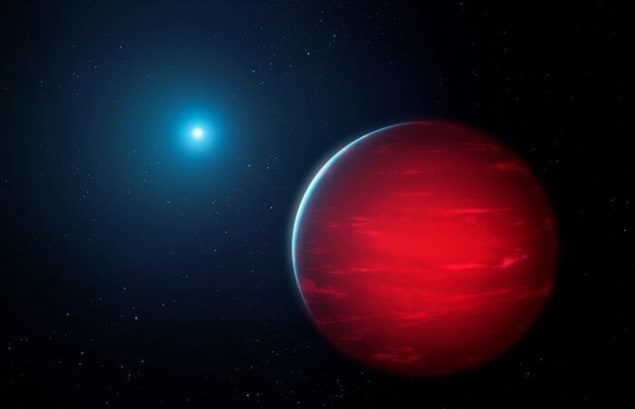Citizen scientist discovers 34 brown dwarfs in binary systems
08 Aug 2022
Two's company Artist’s conception of a brown dwarf in a binary system with a white dwarf star. (Courtesy: NOIRLab/NSF/AURA/M Garlick)
New research has uncovered 34 new binary-star systems in which low-mass stars partner up with a so-called “failed star” or brown dwarf. The discoveries almost double the number of known systems and could help astronomers better understand where the dividing line between planets and stars is.
A key player in the research was citizen scientist Frank Kiwy, who is part of the public project Backyard Worlds: Planet 9. He searched through the 4 billion celestial objects in NOIRLab’s Source Catalog DR2 to find binary systems featuring brown dwarfs.
“Our new discoveries fill out a unique part of the brown dwarf companion population,” NOIRLab astronomer and co-founder of Backyard Worlds, Aaron Meisner told Physics World. “This will help scientists understand whether these mysterious celestial objects are more akin to Jupiter-like oversized planets or rather undersized stars.”
Meisner praised the contribution of the citizen scientist at the heart of the study, which is described in a paper in the The Astronomical Journal. “An extremely talented citizen scientist named Frank Kiwy single-handedly performed all of the data mining, then led a team of professional astronomers to publish the discoveries.”
Hard to spot “failed stars”
In terms of their masses, brown dwarfs fall between planets and stars. NASA currently defines the mass range of brown dwarfs as being 15–75 times the mass of Jupiter, which itself is about 0.1% the mass of the Sun. As a result, brown dwarfs lack the mass to kick start the nuclear fusion of hydrogen in their cores, so they resemble cooling embers rather than dazzling stars. This lack of significant radiation output, coupled with their small size, makes brown dwarfs difficult to observe.
“Brown dwarfs are small, intrinsically dim, and emit largely in infrared light,” Meisner explains. “All of these factors combine to make them both difficult to detect and easy to miss”. However, he points out that, “The large sky area and excellent sensitivity at red wavelengths provided by the NOIRLab Source Catalog were key in enabling these new discoveries”.
Since the first discovery of a brown dwarf , called Teide 1, in 1995, astronomers have discovered thousands of brown dwarfs by using highly sensitive telescopes. But only a small percentage of these have been in binary systems.
“We don’t yet know with much accuracy how common brown dwarf companions to stars are,” Meisner says. “Brown dwarf atmospheres are known to harbour molecules such as water and are essential laboratories that provide unique insights into planetary atmospheres, so it’s critical to find more examples of these intriguing systems.”
Citizen science superusers
In order to hunt brown dwarfs, Backyard Worlds: Planet 9 employs a network of over 100,000 citizen volunteers to scan telescope images. These people use their eyes to search data for features that machine learning and supercomputers may miss.
The volunteers include hundreds of “superusers”, who work on ambitious and self-directed projects and Kiwy is one of these superusers.
“I love the Backyard Worlds: Planet 9 project! Once you master the regular workflow you can dive much deeper into the subject,” Kiwy said in a statement from NOIRLab. “If you’re a person who is curious and not afraid to learn something new, this might be the right thing for you.”
Kiwy was able to spot 2500 potential ultracool brown dwarfs and discovered that 34 of these were paired with either low-mass stars or white dwarfs. The latter being stellar remnants that are left behind when stars like the Sun run out of hydrogen for nuclear fusion.
Powerful archives
“It’s remarkable that modern data archives are so powerful that they can enable professional astronomers – and even enthusiastic amateurs – to make major discoveries, without ever needing to go to a telescope,” Meisner added.READ MORE

From these new discoveries and further research Meisner is hoping to better categorize brown dwarfs. The goal is to establish whether they are more like oversized planets, or if they are closer in nature to undersized stars. Citizen scientists look set to continue to play a role in this investigation.
“We’ll be using some of Earth’s premier telescopes to collect more detailed information about these newly discovered binaries,” Meisner said. “We also suspect that there are more of these discoveries still waiting to be uncovered in existing astronomical data archives – we may even launch a new citizen science project dedicated to finding them!”
Rob Lea is a science writer based in the UK.
from physicsworld.com 15/8/2022

Δεν υπάρχουν σχόλια:
Δημοσίευση σχολίου